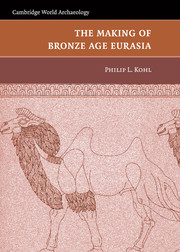Book contents
- Frontmatter
- Contents
- Illustrations and Maps
- Abbreviations
- Preface
- Frontispiece: Eurasian Steppe Zone and the Greater Ancient Near East
- 1 Archaeological Theory and Archaeological Evidence
- 2 The Chalcolithic Prelude – From Social Hierarchies and Giant Settlements to the Emergence of Mobile Economies, ca. 4500–3500 BC
- 3 The Caucasus – Donor and Recipient of Materials, Technologies, and Peoples to and from the Ancient Near East
- 4 Taming the Steppe – The Development of Mobile Economies: From Cattle Herders with Wagons to Horseback Riders Tending Mixed Herds; the Continued Eastward Expansion of Large-Scale Metallurgical Production and Exchange
- 5 Entering a Sown World of Irrigation Agriculture – From the Steppes to Central Asia and Beyond: Processes of Movement, Assimilation, and Transformation into the “Civilized” World East of Sumer
- 6 The Circulation of Peoples and Materials – Evolution, Devolution, and Recurrent Social Formations on the Eurasian Steppes and in West Asia: Patterns and Processes of Interconnection during Later Prehistory
- Appendix
- References
- Index
2 - The Chalcolithic Prelude – From Social Hierarchies and Giant Settlements to the Emergence of Mobile Economies, ca. 4500–3500 BC
Published online by Cambridge University Press: 05 June 2012
- Frontmatter
- Contents
- Illustrations and Maps
- Abbreviations
- Preface
- Frontispiece: Eurasian Steppe Zone and the Greater Ancient Near East
- 1 Archaeological Theory and Archaeological Evidence
- 2 The Chalcolithic Prelude – From Social Hierarchies and Giant Settlements to the Emergence of Mobile Economies, ca. 4500–3500 BC
- 3 The Caucasus – Donor and Recipient of Materials, Technologies, and Peoples to and from the Ancient Near East
- 4 Taming the Steppe – The Development of Mobile Economies: From Cattle Herders with Wagons to Horseback Riders Tending Mixed Herds; the Continued Eastward Expansion of Large-Scale Metallurgical Production and Exchange
- 5 Entering a Sown World of Irrigation Agriculture – From the Steppes to Central Asia and Beyond: Processes of Movement, Assimilation, and Transformation into the “Civilized” World East of Sumer
- 6 The Circulation of Peoples and Materials – Evolution, Devolution, and Recurrent Social Formations on the Eurasian Steppes and in West Asia: Patterns and Processes of Interconnection during Later Prehistory
- Appendix
- References
- Index
Summary
Unter Kupferzeit verstehe ich jenen Zeitabschnitt in der Geschichte der Menschheit, der durch das Auftreten des frühesten Kupfers in Form von Schwergeräten, bzw. durch die Anfänge der zweiten gesellschaftlichen Arbeitsteilung gekennzeichnet ist.
By the Copper Age I understand that period in the history of humanity in which one encounters the earliest copper in the form of heavy functional tools, or in which the beginnings of the second division of labor in society can be recognized.
(H. Todorova 1991: 89)The Copper Age settlements and cemeteries of southeastern Europe, extending from the northern Balkan Peninsula to the northeast across Romania and western Ukraine to the Dnieper, have long been recognized as exceptionally rich and significant. The history of the research on Chalcolithic sites found throughout this interconnected area extends back into the late nineteenth century when scholars first began to excavate the upper levels of what were recognized as settlement mounds with thick cultural deposits (for summary accounts of the histories of research cf. Todorova 1978: 3–6; 1995: 79–82; Fol and Lichardus 1988: 19–26; Monah and Monah 1997: 21–34; Arkheologiya Ukrainskoi SSR 1985: 189–193).
State-funded archaeological research led to an enormous compilation of archaeological materials, a record which for sixth- and fifth-millennia times is arguably as, or more, complete than any other area of the world. Numerous artificially raised settlement hills, tepes and tells of the Near Eastern type, are distributed throughout Bulgaria and southern Romania (Figs. 2.1–2.3).
- Type
- Chapter
- Information
- The Making of Bronze Age Eurasia , pp. 23 - 56Publisher: Cambridge University PressPrint publication year: 2007



